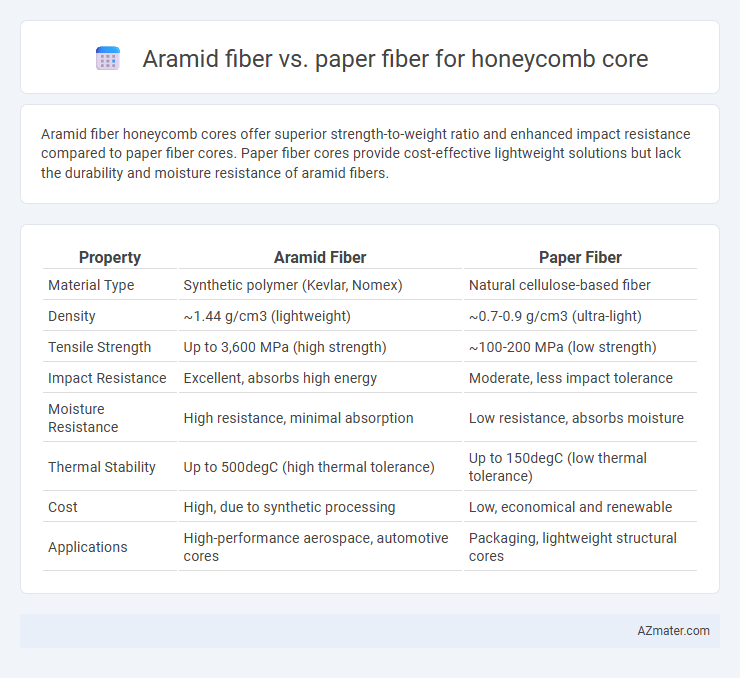Aramid fiber honeycomb cores offer superior strength-to-weight ratio and enhanced impact resistance compared to paper fiber cores. Paper fiber cores provide cost-effective lightweight solutions but lack the durability and moisture resistance of aramid fibers.
Table of Comparison
| Property | Aramid Fiber | Paper Fiber |
|---|---|---|
| Material Type | Synthetic polymer (Kevlar, Nomex) | Natural cellulose-based fiber |
| Density | ~1.44 g/cm3 (lightweight) | ~0.7-0.9 g/cm3 (ultra-light) |
| Tensile Strength | Up to 3,600 MPa (high strength) | ~100-200 MPa (low strength) |
| Impact Resistance | Excellent, absorbs high energy | Moderate, less impact tolerance |
| Moisture Resistance | High resistance, minimal absorption | Low resistance, absorbs moisture |
| Thermal Stability | Up to 500degC (high thermal tolerance) | Up to 150degC (low thermal tolerance) |
| Cost | High, due to synthetic processing | Low, economical and renewable |
| Applications | High-performance aerospace, automotive cores | Packaging, lightweight structural cores |
Introduction to Honeycomb Core Materials
Honeycomb core materials primarily consist of aramid fiber and paper fiber, each offering distinct performance benefits in lightweight structural applications. Aramid fiber cores, known for high tensile strength and impact resistance, provide superior durability and energy absorption compared to traditional paper fibers. Paper fiber honeycomb cores are favored for their cost-effectiveness and sustainability, making them suitable for less demanding load environments.
Overview of Aramid Fiber Honeycomb Cores
Aramid fiber honeycomb cores offer exceptional strength-to-weight ratios, making them ideal for aerospace and automotive applications requiring high impact resistance and energy absorption. These cores exhibit superior thermal stability and chemical resistance compared to paper fiber cores, ensuring durability in harsh environments. Their consistent cell structure and lightweight properties enhance mechanical performance while maintaining low density for efficient composite manufacturing.
Overview of Paper Fiber Honeycomb Cores
Paper fiber honeycomb cores consist of cellulose-based fibers bonded with resin, offering a lightweight and cost-effective solution with good compressive strength and energy absorption. These cores excel in applications requiring moderate mechanical properties, corrosion resistance, and ease of fabrication, making them ideal for aerospace, automotive, and packaging industries. Paper fiber honeycomb cores provide excellent thermal insulation and damping characteristics, contributing to vibration reduction in structural assemblies.
Mechanical Strength Comparison
Aramid fiber honeycomb cores exhibit superior mechanical strength compared to paper fiber cores, offering higher tensile strength and enhanced impact resistance. The tensile strength of aramid fiber cores can exceed 300 MPa, while paper fiber cores typically range between 50-100 MPa, highlighting aramid's robustness in load-bearing applications. Aramid cores also demonstrate better fatigue resistance and energy absorption, making them ideal for aerospace and automotive structural components.
Weight and Density Differences
Aramid fiber honeycomb cores typically offer a density range between 30 to 70 kg/m3, significantly lighter than standard paper fiber cores, which range from 80 to 120 kg/m3. The lower density of aramid fibers contributes to a substantial weight reduction in composite structures, enhancing overall strength-to-weight ratios crucial for aerospace and automotive applications. Paper fiber cores, while denser and heavier, provide cost-effective solutions but lack the superior impact resistance and durability exhibited by aramid fiber cores.
Fire Resistance and Thermal Stability
Aramid fiber honeycomb cores exhibit superior fire resistance and thermal stability compared to paper fiber cores, withstanding temperatures up to 400degC without significant degradation. Paper fiber cores typically ignite at lower temperatures around 200degC and lack the thermal insulative properties necessary for high-temperature applications. The enhanced flame retardancy and thermal endurance of aramid cores make them ideal for aerospace and automotive structures requiring stringent fire safety standards.
Moisture and Environmental Durability
Aramid fiber honeycomb cores exhibit superior moisture resistance compared to paper fiber cores, reducing swelling and maintaining structural integrity in high-humidity environments. The inherent chemical stability of aramid fibers also enhances environmental durability, enabling better performance against UV exposure, temperature fluctuations, and chemical degradation. Paper fiber cores, while cost-effective, are more susceptible to moisture absorption and environmental deterioration, limiting their application in demanding conditions.
Cost and Manufacturing Considerations
Aramid fiber honeycomb cores offer superior strength-to-weight ratios and impact resistance compared to paper fiber, but they come at a significantly higher material cost, making them less economical for large-scale or budget-sensitive projects. Manufacturing with aramid fiber involves more complex processes such as resin impregnation and curing, requiring specialized equipment and longer production times, whereas paper fiber cores are simpler to produce with conventional methods like gluing and pressing. The choice between aramid and paper fiber cores depends on balancing performance requirements against cost-efficiency and manufacturing capabilities.
Typical Applications and Industry Usage
Aramid fiber honeycomb cores are frequently used in aerospace, automotive, and defense industries due to their superior strength-to-weight ratio, impact resistance, and flame retardancy, making them ideal for structural panels and lightweight reinforcement. Paper fiber honeycomb cores find typical applications in packaging, furniture, and construction industries because of their cost-effectiveness, ease of customization, and environmentally friendly biodegradable properties. The selection between aramid and paper fiber cores depends heavily on performance requirements such as durability and weight versus economic and sustainable considerations in end-use scenarios.
Summary: Choosing the Right Honeycomb Core Material
Aramid fiber honeycomb cores provide exceptional strength-to-weight ratios, impact resistance, and durability, making them ideal for aerospace and high-performance applications. Paper fiber cores offer cost-effective, lightweight solutions suitable for interior and low-stress structural components but lack the mechanical robustness of aramid fibers. Selecting the right honeycomb core material depends on balancing performance requirements, budget constraints, and environmental conditions.

Infographic: Aramid fiber vs Paper fiber for Honeycomb core
 azmater.com
azmater.com